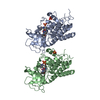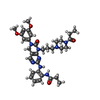[English] 日本語
 Yorodumi
Yorodumi- PDB-7v29: Crystal structure of FGFR4 with a dual-warhead covalent inhhibitor -
+ Open data
Open data
- Basic information
Basic information
| Entry | Database: PDB / ID: 7v29 | |||||||||
|---|---|---|---|---|---|---|---|---|---|---|
| Title | Crystal structure of FGFR4 with a dual-warhead covalent inhhibitor | |||||||||
 Components Components | Fibroblast growth factor receptor 4 | |||||||||
 Keywords Keywords | TRANSFERASE / Inhibitor / Dual-warhead / Fibroblast growth factor receptor 4 / Covalent | |||||||||
| Function / homology |  Function and homology information Function and homology informationFGFR4 mutant receptor activation / betaKlotho-mediated ligand binding / regulation of extracellular matrix disassembly / positive regulation of catalytic activity / phosphate ion homeostasis / regulation of bile acid biosynthetic process / FGFR4 ligand binding and activation / Phospholipase C-mediated cascade; FGFR4 / fibroblast growth factor receptor activity / positive regulation of DNA biosynthetic process ...FGFR4 mutant receptor activation / betaKlotho-mediated ligand binding / regulation of extracellular matrix disassembly / positive regulation of catalytic activity / phosphate ion homeostasis / regulation of bile acid biosynthetic process / FGFR4 ligand binding and activation / Phospholipase C-mediated cascade; FGFR4 / fibroblast growth factor receptor activity / positive regulation of DNA biosynthetic process / PI-3K cascade:FGFR4 / fibroblast growth factor binding / positive regulation of proteolysis / regulation of lipid metabolic process / PI3K Cascade / fibroblast growth factor receptor signaling pathway / SHC-mediated cascade:FGFR4 / Signaling by FGFR4 in disease / transport vesicle / FRS-mediated FGFR4 signaling / peptidyl-tyrosine phosphorylation / cholesterol homeostasis / Negative regulation of FGFR4 signaling / receptor protein-tyrosine kinase / Constitutive Signaling by Aberrant PI3K in Cancer / cell migration / PIP3 activates AKT signaling / glucose homeostasis / heparin binding / protein autophosphorylation / PI5P, PP2A and IER3 Regulate PI3K/AKT Signaling / RAF/MAP kinase cascade / positive regulation of ERK1 and ERK2 cascade / receptor complex / endosome / positive regulation of cell population proliferation / positive regulation of gene expression / endoplasmic reticulum / Golgi apparatus / extracellular region / ATP binding / plasma membrane Similarity search - Function | |||||||||
| Biological species |  Homo sapiens (human) Homo sapiens (human) | |||||||||
| Method |  X-RAY DIFFRACTION / X-RAY DIFFRACTION /  SYNCHROTRON / SYNCHROTRON /  MOLECULAR REPLACEMENT / Resolution: 1.983 Å MOLECULAR REPLACEMENT / Resolution: 1.983 Å | |||||||||
 Authors Authors | Chen, X.J. / Jiang, L.Y. / Dai, S.Y. / Qu, L.Z. / Chen, Y.H. | |||||||||
| Funding support |  China, 2items China, 2items
| |||||||||
 Citation Citation |  Journal: Commun Chem / Year: 2022 Journal: Commun Chem / Year: 2022Title: Structure-based design of a dual-warhead covalent inhibitor of FGFR4. Authors: Chen, X. / Li, H. / Lin, Q. / Dai, S. / Yue, S. / Qu, L. / Li, M. / Guo, M. / Wei, H. / Li, J. / Jiang, L. / Xu, G. / Chen, Y. | |||||||||
| History |
|
- Structure visualization
Structure visualization
| Structure viewer | Molecule:  Molmil Molmil Jmol/JSmol Jmol/JSmol |
|---|
- Downloads & links
Downloads & links
- Download
Download
| PDBx/mmCIF format |  7v29.cif.gz 7v29.cif.gz | 140.7 KB | Display |  PDBx/mmCIF format PDBx/mmCIF format |
|---|---|---|---|---|
| PDB format |  pdb7v29.ent.gz pdb7v29.ent.gz | 108.4 KB | Display |  PDB format PDB format |
| PDBx/mmJSON format |  7v29.json.gz 7v29.json.gz | Tree view |  PDBx/mmJSON format PDBx/mmJSON format | |
| Others |  Other downloads Other downloads |
-Validation report
| Summary document |  7v29_validation.pdf.gz 7v29_validation.pdf.gz | 1.1 MB | Display |  wwPDB validaton report wwPDB validaton report |
|---|---|---|---|---|
| Full document |  7v29_full_validation.pdf.gz 7v29_full_validation.pdf.gz | 1.1 MB | Display | |
| Data in XML |  7v29_validation.xml.gz 7v29_validation.xml.gz | 28.2 KB | Display | |
| Data in CIF |  7v29_validation.cif.gz 7v29_validation.cif.gz | 40.6 KB | Display | |
| Arichive directory |  https://data.pdbj.org/pub/pdb/validation_reports/v2/7v29 https://data.pdbj.org/pub/pdb/validation_reports/v2/7v29 ftp://data.pdbj.org/pub/pdb/validation_reports/v2/7v29 ftp://data.pdbj.org/pub/pdb/validation_reports/v2/7v29 | HTTPS FTP |
-Related structure data
| Related structure data |  4qrcS S: Starting model for refinement |
|---|---|
| Similar structure data | Similarity search - Function & homology  F&H Search F&H Search |
- Links
Links
- Assembly
Assembly
| Deposited unit | 
| ||||||||
|---|---|---|---|---|---|---|---|---|---|
| 1 | 
| ||||||||
| 2 | 
| ||||||||
| Unit cell |
|
- Components
Components
| #1: Protein | Mass: 34695.059 Da / Num. of mol.: 2 / Mutation: R664E Source method: isolated from a genetically manipulated source Source: (gene. exp.)  Homo sapiens (human) / Gene: FGFR4, JTK2, TKF Homo sapiens (human) / Gene: FGFR4, JTK2, TKFProduction host:  References: UniProt: P22455, receptor protein-tyrosine kinase #2: Chemical | #3: Chemical | ChemComp-SO4 / #4: Water | ChemComp-HOH / | Has ligand of interest | Y | Has protein modification | Y | |
|---|
-Experimental details
-Experiment
| Experiment | Method:  X-RAY DIFFRACTION / Number of used crystals: 1 X-RAY DIFFRACTION / Number of used crystals: 1 |
|---|
- Sample preparation
Sample preparation
| Crystal | Density Matthews: 2.18 Å3/Da / Density % sol: 43.46 % |
|---|---|
| Crystal grow | Temperature: 277.15 K / Method: vapor diffusion, hanging drop / pH: 4.5 Details: 0.1 M Bis-Tris (pH 4.5), 0.2 M Li2SO4, 20% PEG 3350 |
-Data collection
| Diffraction | Mean temperature: 85 K / Serial crystal experiment: N |
|---|---|
| Diffraction source | Source:  SYNCHROTRON / Site: SYNCHROTRON / Site:  SSRF SSRF  / Beamline: BL17U / Wavelength: 0.97915 Å / Beamline: BL17U / Wavelength: 0.97915 Å |
| Detector | Type: ADSC QUANTUM 315r / Detector: CCD / Date: May 31, 2020 |
| Radiation | Protocol: SINGLE WAVELENGTH / Monochromatic (M) / Laue (L): M / Scattering type: x-ray |
| Radiation wavelength | Wavelength: 0.97915 Å / Relative weight: 1 |
| Reflection | Resolution: 1.983→64.345 Å / Num. obs: 41464 / % possible obs: 99.81 % / Redundancy: 6.7 % / Biso Wilson estimate: 21.75 Å2 / CC1/2: 0.996 / Rmerge(I) obs: 0.116 / Rrim(I) all: 0.1262 / Net I/σ(I): 10.96 |
| Reflection shell | Resolution: 1.983→2.053 Å / Rmerge(I) obs: 0.3257 / Mean I/σ(I) obs: 2.37 / Num. unique obs: 4064 / CC1/2: 0.944 |
- Processing
Processing
| Software |
| ||||||||||||||||||||||||||||||||||||||||||||||||||||||||||||||||||||||||||||||||||||||||||
|---|---|---|---|---|---|---|---|---|---|---|---|---|---|---|---|---|---|---|---|---|---|---|---|---|---|---|---|---|---|---|---|---|---|---|---|---|---|---|---|---|---|---|---|---|---|---|---|---|---|---|---|---|---|---|---|---|---|---|---|---|---|---|---|---|---|---|---|---|---|---|---|---|---|---|---|---|---|---|---|---|---|---|---|---|---|---|---|---|---|---|---|
| Refinement | Method to determine structure:  MOLECULAR REPLACEMENT MOLECULAR REPLACEMENTStarting model: 4QRC Resolution: 1.983→64.345 Å / SU ML: 0.23 / Cross valid method: THROUGHOUT / σ(F): 1.34 / Phase error: 27.73 / Stereochemistry target values: ML
| ||||||||||||||||||||||||||||||||||||||||||||||||||||||||||||||||||||||||||||||||||||||||||
| Solvent computation | Shrinkage radii: 0.9 Å / VDW probe radii: 1.11 Å / Solvent model: FLAT BULK SOLVENT MODEL | ||||||||||||||||||||||||||||||||||||||||||||||||||||||||||||||||||||||||||||||||||||||||||
| Displacement parameters | Biso max: 98.61 Å2 / Biso mean: 27.8686 Å2 / Biso min: 8.7 Å2 | ||||||||||||||||||||||||||||||||||||||||||||||||||||||||||||||||||||||||||||||||||||||||||
| Refinement step | Cycle: final / Resolution: 1.983→64.345 Å
| ||||||||||||||||||||||||||||||||||||||||||||||||||||||||||||||||||||||||||||||||||||||||||
| Refine LS restraints |
| ||||||||||||||||||||||||||||||||||||||||||||||||||||||||||||||||||||||||||||||||||||||||||
| LS refinement shell | Refine-ID: X-RAY DIFFRACTION / Rfactor Rfree error: 0
|
 Movie
Movie Controller
Controller


 PDBj
PDBj









